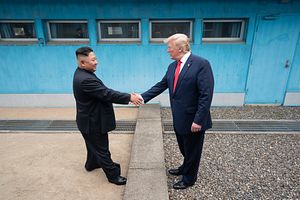In a world where very few states have nuclear weapons — namely, the victors of the Second World War and a handful of others — what strategies has the United States employed to prevent additional states from acquiring “the bomb”?
A tailored, case-by-case approach to nuclear nonproliferation may seem like the best way to ensure outcomes most favorable to the United States. After all, Iran is different from North Korea, which was different from South Africa, which was different from Ukraine — so why have a “one-size-fits-all” nonproliferation strategy?
Look at the two difficult cases that have posed the greatest nuclear proliferation risks in recent years: North Korea and Iran. Admittedly, in almost all respects, these countries are different: different theaters, different regional dynamics, different domestic pressures and incentives. Most importantly, North Korea has nuclear weapons, and Iran does not.
However, it is not possible to separate these cases entirely and pretend that the North Korean and Iranian leaders are unaware of U.S. strategies towards the other. In 2018, the Trump administration withdrew from the 2015 nuclear deal (the Joint Comprehensive Plan of Action) with which Iran was in full compliance (and that was widely considered by the nuclear security community to be better than the status quo). This was followed by a sharp rise in tensions in the Middle East, leading eventually to another crescendo with the recent killing of top-level Iranian general Qasem Soleimani.
Simultaneously, the U.S. has engaged North Korea by participating in several summits and high-level meetings after that country’s leader, Kim Jong Un, authorized several nuclear and missile tests demonstrating a serious capability. Additionally, concessions such as the postponement of military exercises were made in hopes of bringing Kim to the table for a negotiated denuclearization deal.
U.S. messaging toward both countries, viewed together, seemed to be one of rewarding bad behavior while punishing compliant conduct, or, that once a state actually gets nuclear weapons, it’s home free. Additionally, any serious nuclear negotiations with North Korea are undermined by concerns that the United States might later withdraw from whatever agreement is reached as it did with Iran. Not only is such messaging inconsistent and confusing, it is deleterious to the global nonproliferation regime.
Certainly it is an American priority to prevent additional states from acquiring nuclear weapons, but one must also consider why a specific country is seeking such weapons in the first place — often it is because it feels there is some existential security threat that it is otherwise unable to deter. Making the adversary acutely aware of these vulnerabilities may only reinforce its decision to seek the security “insurance policy” that the adversary believes nuclear weapons provide.
The nuclear ambitions of North Korea and Iran have challenged previous American administrations and they will continue to do so. However, the way the Trump administration has handled both cases in recent years demonstrates a serious cognitive dissonance in U.S. nonproliferation strategy. Carrots and sticks each have their places in the power projection toolbox. When used in a comprehensible, compatible way, their effect is multiplied and they become more valuable. When used in conflicting ways, the effect of each is undermined.
The United States can try to square its nonproliferation strategies toward North Korea and Iran by continuing to engage diplomatically with Pyongyang, and by reentering and attempting to pull Iran back into compliance in the Joint Comprehensive Plan of Action while there is still time to prevent a tenth state from acquiring nuclear weapons.
Mary Chesnut is the Program Manager at the Nuclear Security Working Group (NSWG) at the George Washington University. The views reflected in this article are the author’s alone and do not reflect the views of any of the institutions mentioned above.

































